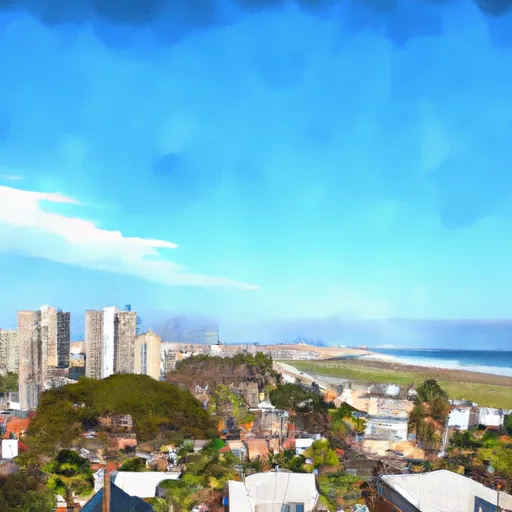-
 Snoflo Premium
Snoflo Premium
Get unlimited access to all our content
With no Ad interruptions! - Start Your Free Trial Login with existing account
Surfside
Eden Index
Climate
8.8
•
Recreation
5.4
•
Community
6.7
•
Safeguard
7.1/10

Surfside, California is a small coastal community situated in Orange County. Known for its breathtaking beaches and picturesque landscape, the town experiences a Mediterranean climate characterized by mild, wet winters and warm, dry summers. The average temperature ranges from the high 60s°F (20°C) in summer to the mid-50s°F (13°C) in winter. This pleasant climate attracts visitors and residents alike, making outdoor activities enjoyable year-round.
Hydrologically, Surfside is located between the Pacific Ocean and Anaheim Bay. The town benefits from the presence of the ocean, providing opportunities for swimming, surfing, and beachcombing. Additionally, the adjacent Anaheim Bay offers the possibility of kayaking, fishing, and boating. The water quality in Surfside is monitored regularly to ensure a safe and clean environment for recreation.
Outdoor enthusiasts can explore the nearby Bolsa Chica Ecological Reserve, a wetland area rich in biodiversity. This reserve offers birdwatching, nature walks, and educational programs. Moreover, the Huntington Beach State Park, located just south of Surfside, provides opportunities for hiking, biking, camping, and picnicking.
Overall, Surfside, California offers a favorable climate, beautiful hydrological features, and diverse outdoor recreation options, making it an appealing destination for nature lovers and adventure seekers.
What is the Eden Index?
The Snoflo Eden Index serves as a comprehensive rating system for regions, evaluating their desirability through a holistic assessment of climate health, outdoor recreation opportunities, and natural disaster risk, acknowledging the profound impact of these factors on livability and well-being.
Climate Health Indicator (CHI): 8.8
Surfside receives approximately
310mm of rain per year,
with humidity levels near 75%
and air temperatures averaging around
18°C.
Surfside has a plant hardyness factor of
10, meaning
plants and agriculture in this region tend to thrive here all year round.
By considering the ideal temperature range, reliable water supplies, clean air, and stable seasonal rain or snowpacks, the Climate Health Indicator (CHI) underscores the significance of a healthy climate as the foundation for quality living.
A healthy climate is paramount for ensuring a high quality of life and livability in a region, fostering both physical well-being and environmental harmony. This can be characterized by ideal temperatures, reliable access to water supplies, clean air, and consistent seasonal rain or snowpacks.
Weather Forecast
Streamflow Conditions
Santa Ana
Area Rivers
Santa Ana
Snowpack Depths
Santa Ana
Reservoir Storage Capacity
Santa Ana
Groundwater Levels
Recreational Opportunity Index (ROI): 5.4
The Recreational Opportunity Index (ROI) recognizes the value of outdoor recreational options, such as parks, hiking trails, camping sites, and fishing spots, while acknowledging that climate plays a pivotal role in ensuring the comfort and consistency of these experiences.
Access to outdoor recreational opportunities, encompassing activities such as parks, hiking, camping, and fishing, is crucial for overall well-being, and the climate plays a pivotal role in enabling and enhancing these experiences, ensuring that individuals can engage in nature-based activities comfortably and consistently.
Camping Areas
| Campground | Campsites | Reservations | Toilets | Showers | Elevation |
|---|---|---|---|---|---|
| Los Alamitos Army Military | None | 25 ft | |||
| Seabreeze at Seal Beach Military | None | 15 ft | |||
| Sunset Vista RV Park | None | 19 ft | |||
| Bolsa Chica State Beach | 57 | 12 ft |
Catastrophe Safeguard Index (CSI):
The Catastrophe Safeguard Index (CSI) recognizes that natural disaster risk, encompassing floods, fires, hurricanes, and tornadoes, can drastically affect safety and the overall appeal of an area.
The level of natural disaster risk in a region significantly affects safety and the overall livability, with climate change amplifying these risks by potentially increasing the frequency and intensity of events like floods, fires, hurricanes, and tornadoes, thereby posing substantial challenges to community resilience and well-being.
Community Resilience Indicator (CRI): 6.7
The Community Resilience Indicator (CRI) recognizes that education, healthcare, and socioeconomics are crucial to the well-being of a region. The CRI acknowledges the profound impact of these elements on residents' overall quality of life. By evaluating educational resources, healthcare accessibility, and economic inclusivity, the index captures the essential aspects that contribute to a thriving community, fostering resident satisfaction, equity, and social cohesion.

